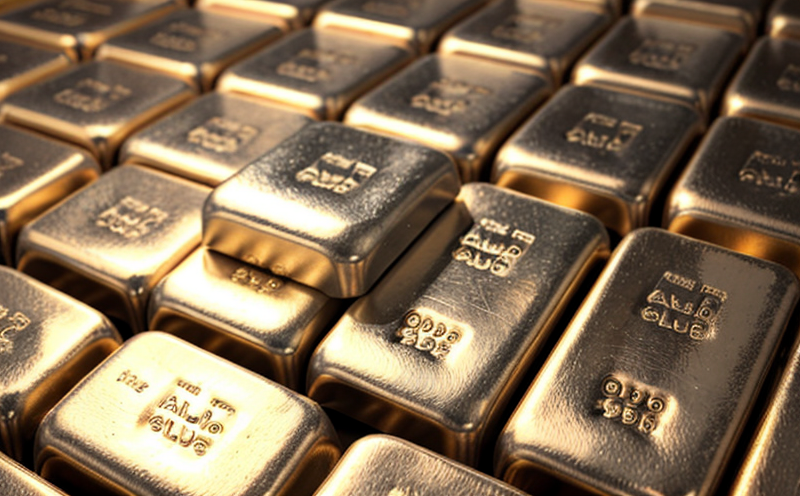ASTM E1336 Fire Assay Determination of Silver Testing
The ASTM E1336 fire assay method is a fundamental technique used to determine the silver content in precious metals and alloys. This testing process involves melting samples with fluxes, which decompose at high temperatures, releasing volatile compounds that are captured by the carrier gas (usually sulfur dioxide). The resulting precipitate, which contains silver, is then weighed to calculate its percentage relative to the original sample.
This method is particularly useful in mining and precious metals sectors where accurate quantification of silver content is crucial for quality assurance, compliance, and value assessment. The ASTM E1336 process is recognized internationally, ensuring consistency and reliability across different laboratories and jurisdictions.
Accurate determination of silver content through fire assay helps in:
- Evaluating the purity of precious metals and alloys
- Aiding in compliance with industry standards and regulations
- Supporting R&D efforts to develop new materials or refine existing processes
- Precisely calculating the value of mined ores and refined products containing silver
The precision and reliability of ASTM E1336 fire assay make it a preferred method for quality managers, compliance officers, and R&D engineers. For procurement teams, knowing the silver content in purchased materials ensures adherence to specified standards.
Given its importance in the mining sector, this testing process is often performed using advanced equipment such as muffle furnaces and infrared detection systems. Samples are prepared with specific methods tailored to the composition of the precious metal or alloy being analyzed.
Scope and Methodology
The ASTM E1336 fire assay method covers a range of precious metals, including silver, gold, platinum, palladium, and others. The primary scope is to determine the total amount of silver present in the sample through precise quantitative analysis.
The methodology involves several steps:
- Sample preparation: Ensuring the sample is representative and free from contamination
- Melting with flux: Using a flux such as borax or sodium carbonate to decompose the sample at high temperatures (typically 1200°C)
- Capture of volatiles: Sulfur dioxide gas captures the released compounds, which include silver
- Calculation: Weighing the precipitate to determine its mass and calculating it as a percentage of the original sample
The process is designed to be robust and reproducible, ensuring consistent results across different laboratories. This is achieved through adherence to specific standards such as ASTM E1336.
Quality assurance in this method involves:
- Demonstrating the repeatability of results
- Ensuring the accuracy of weighing equipment and instruments
- Maintaining strict temperature controls during the melting process
- Using high-quality fluxes to ensure complete decomposition
The precision of this method is critical for industries reliant on accurate metal content analysis. It supports compliance with international standards and ensures that products meet specified purity levels.
Industry Applications
- Mining Sector: Used to evaluate the silver content in ores and refined products, aiding in quality control and value assessment.
- Precious Metals Refining: Essential for ensuring product purity meets market demand.
- R&D Laboratories: Supports innovation by providing accurate data on metal composition.
- Compliance: Ensures adherence to international standards and regulations regarding precious metals content.
The ASTM E1336 fire assay method is widely used in these applications, offering a reliable way to determine the silver content in various samples. Its application spans multiple industries, from jewelry manufacturing to electronic components, where precise metal content analysis is crucial.
By using this method, companies can ensure consistent product quality and meet regulatory requirements effectively. This ensures that products are not only of high quality but also compliant with international standards like ASTM E1336.
Eurolab Advantages
At Eurolab, we pride ourselves on providing precise and reliable testing services. Our expertise in the ASTM E1336 fire assay method ensures that our clients receive accurate results every time:
- Accurate Results: Utilizing state-of-the-art equipment and experienced technicians.
- Compliance: Ensuring that all tests meet international standards like ASTM E1336.
- Precision: Maintaining strict temperature controls and using high-quality fluxes.
- Rapid Turnaround: Providing quick results without compromising on accuracy.
Our commitment to excellence in testing services is reflected in our reputation for delivering accurate, reliable, and compliant results. This ensures that clients can trust us with their precious metals testing needs.
We are dedicated to helping mining companies, refineries, R&D labs, and compliance officers make informed decisions about the quality of their products. Our expertise in ASTM E1336 fire assay method enables us to provide reliable data for all stakeholders involved in the precious metals industry.





